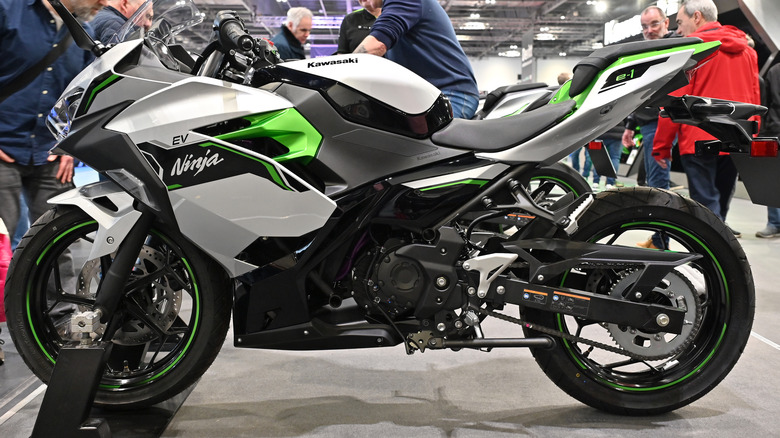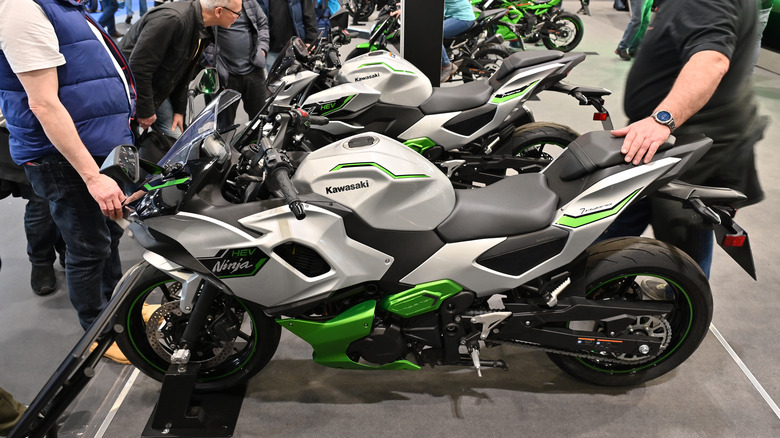By Brad Hill/
As time passes, systems change, forcing many to adapt. Car brands are dipping their toes into the electric vehicle (EV) pool, gradually making the transition to more hybrid and fully electric vehicles on the road. Motorcycle brands are starting to see the same changes, with Kawasaki, one of the top-ranked motorcycle brands, fully embracing it.
The Japanese motorcycle manufacturer announced its first fully electric bike, the Ninja e-1, in September 2023. Kawasaki followed up that announcement in January 2024 with news that it was bringing its hybrid bike, the Ninja 7 Hybrid, to the States. Despite sharing the Ninja name, they each offer vastly different riding experiences.
For starters, the Ninja 7 Hybrid can make those long cross-country trips when the mood strikes. The Ninja e-1, on the other hand, isn’t built to replace traditional motorcycles. It’s meant for those short commutes through a large metropolitan city or making it from home to school and back, which can save a lot in Uber fees. Read on for more significant differences.
Kawasaki goes full electric

John Keeble/Getty Images
Kawasaki developed the Ninja e-1 with the same trellis frame as the flagship Ninja H2. While it’s considerably lighter than many of the other bikes in Kawasaki’s line-up, it still weighs 309 pounds. For comparison, the Ninja 7 Hybrid weighs 502.7 pounds and the Ninja 400 comes in at 366 pounds.
Unlike the traditional motorcycles Kawasaki is known for, the Ninja e-1 ABS is powered by a brushless electric motor rated at 5.0kW, eliminating the need for a clutch. Where riders typically find the gas tank of a motorcycle, an e-1 owner will find dual lithium-ion batteries that each weigh 25.3 pounds. The range they offer on a full charge is 41 miles, which puts this full-sized motorcycle more in line with an electric scooter rather than its gas-powered siblings.
Kawasaki designed the bike with regenerative braking, which means the energy generated during deceleration is recycled back into the battery. This feature kicks in when the batteries are at a 60% charge. Furthermore, the bike can be set to one of two modes: Road or Eco mode. Road mode will let the rider reach the bike’s max speed, which is 55mph unless e-boost is engaged. With e-boost, the max speed tops out at 65mph. Eco mode, on the other hand, only allows for a maximum of 40mph in order to conserve energy. Eco mode is automatically engaged if only one battery pack is in use.
The hybrid

John Keeble/Getty Images
Unlike the Ninja e-1 the Ninja 7 Hybrid’s gas-powered engine is paired with an electric motor rated at 7.0kW. Thus, the «Hybrid» in its name. Also, unlike the Ninja e-1, the Ninja 7 gives riders three different modes to choose from. For full power, they can select the Sport-Hybrid mode. If they want optimal fuel efficiency, the rider can select the Eco-Hybrid mode. Then there’s the third mode, called EV mode, which switches into an all-electric, zero-emission driving experience intended for short-distance rides.
The Ninja 7 Hybrid has an automated manual transmission that eliminates a few features found on conventional motorcycles, including the clutch lever and left-foot shift pedal. If riders want to operate the transmission manually, they have to use the shift buttons located on the left shift gear. Ferrari did something similar with its manual transmissions.
It probably won’t be one of Kawasaki’s fastest bikes, but its six-speed transmission will let it keep up with the best of them. The nice part about a hybrid bike is there’s no need to plug the Ninja 7 into a charging bay. The 48V lithium-ion battery pack, located beneath the seat, charges during rides.